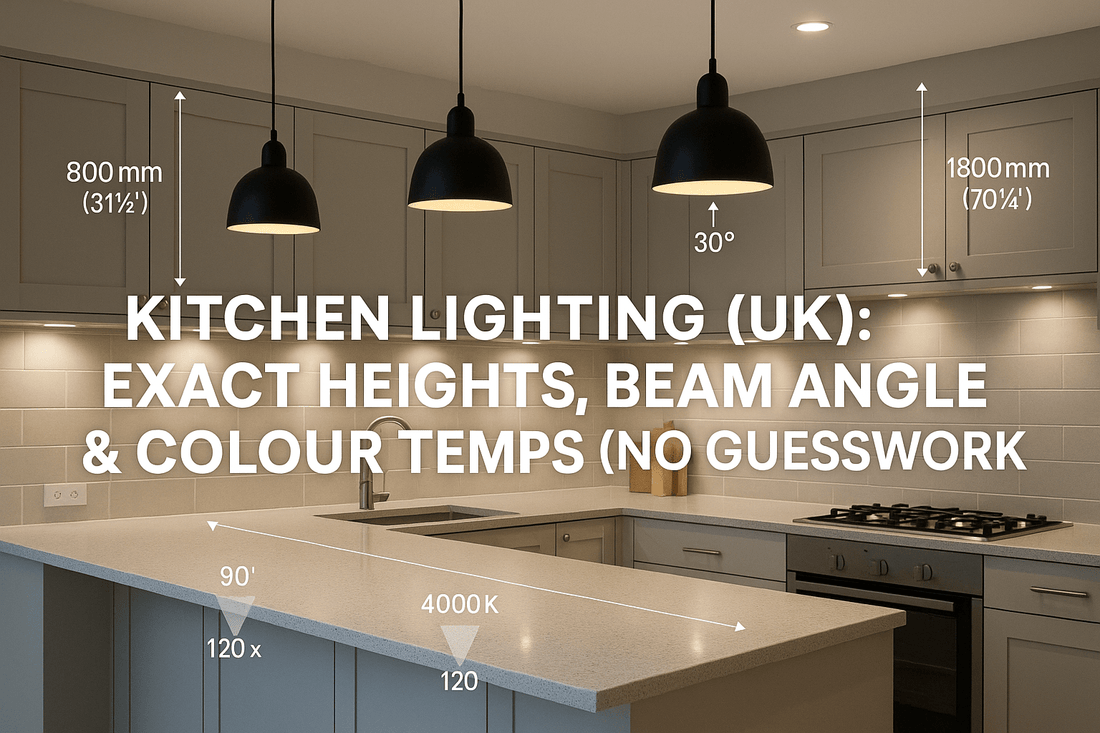
Kitchen Lighting (UK): Exact Heights, Beam Angles & Colour Temps (No Guesswork)
Share
Lighting makes or breaks a kitchen. It shapes how colours read, how big the room feels, and even how relaxed you are while cooking. In 2025, British homeowners are getting more technical — measuring beam angles, lumen output and colour temperature instead of just picking bulbs by eye. Here’s how to plan your lighting so it looks natural and performs flawlessly.
1. Understand the Three Layers of Kitchen Lighting
- Ambient: The general fill light from ceiling pendants or downlights — aim for 300–500 lux overall.
- Task: Focused lighting over worktops, sinks and hobs. Under-cabinet LEDs are ideal; see our guide to DIY kitchen light upgrades.
- Accent: Decorative or mood lighting that highlights textures, shelving or islands. Often warmer in tone (2700 K).
2. Correct Mounting Heights (UK Guidelines)
- Pendants over islands: 75–90 cm above the worktop, or around 150 cm from the floor for balanced sightlines.
- Wall lights: Mount at roughly 150–160 cm from the floor so light spreads evenly without glare.
- Downlights: Space 90–120 cm apart for uniform coverage, avoiding shadows on prep areas.
3. Beam Angles & Brightness
- Wide (90°–120°): Best for general ceiling lighting.
- Medium (60°–80°): Perfect for over-island or peninsula zones.
- Narrow (30°–40°): Accent or art lighting — use sparingly to avoid harsh contrast.
- Combine wide and medium angles to make compact kitchens appear broader, especially in flats like those featured in Hidden Storage Hacks for Small Kitchens.
4. Choose the Right Colour Temperature
| Area | Recommended Kelvin (K) | Effect |
|---|---|---|
| General / Ambient | 3000 – 3500 K | Neutral white, balanced and clean |
| Task areas | 3500 – 4000 K | Crisp visibility for chopping & prep |
| Dining / Relax zones | 2700 – 3000 K | Warm, comfortable atmosphere |
5. Lighting & Material Coordination
- Soft light flatters painted cabinetry — explore palettes in Shaker-style kitchens.
- Quartz and other reflective worktops amplify brightness — learn more about sustainability benefits in eco-friendly materials.
- Choose warm brass or matte black fittings to match handles and taps for cohesive design.
6. Smart & Energy-Saving Options
- Install dimmable LED drivers and smart switches — they extend bulb life and let you tune light levels for mood or time of day.
- Motion sensors under cabinets reduce wasted energy — ideal for night-time navigation.
- Check bulb CRI (Colour Rendering Index) > 90 to keep food tones natural.
Lighting isn’t decoration; it’s design. Plan it with the same care as your cabinets and worktops, and your kitchen will not only look better — it’ll feel better to live in.
Frequently Asked Questions
What colour temperature is best for a UK kitchen?
Use neutral-white LEDs around 3500 K for main lighting, warmer 2700 K for dining areas, and cooler 4000 K for detailed prep zones. Mixing tones adds depth.
How high should island pendants hang?
Roughly 75–90 cm above the worktop or 150 cm from the floor keeps lights even and out of sightlines.
How many downlights do I need?
Allow one downlight per 1.2 m² of floor area as a rule of thumb, spacing 90–120 cm apart. Focus extra lights above sinks and worktops.
